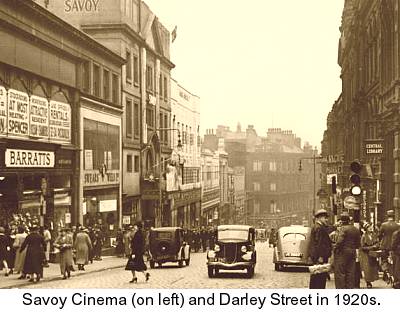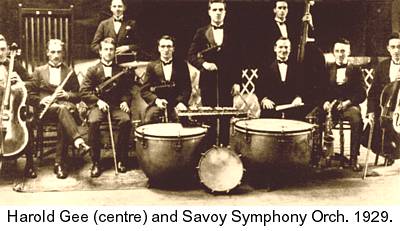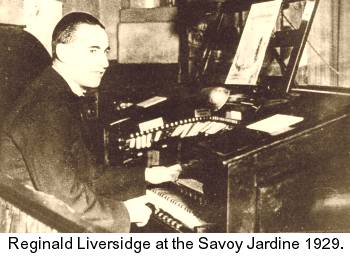|
Savoy Cinema Darley Street, Bradford.

Location The Building The simple but elegant façade has a central entrance with steps up to the foyer. A canopy projected out over the pavement, above which was a half-moon central window with similar half-moon ornamentation above. Two central columns rising through the second and third floors to form an apex on the façade of the fourth floor. The name Savoy was picked out in neon at third floor level. Interior 
The shallow stage had little room for anything more than the screen and house tabs. The orchestra pit could accommodate the ten-strong Savoy Cinema Symphony Orchestra conducted by Harold Gee with his Stradivarius violin - he was also a favourite at the Theatre Royal when he played there. Timpanist was Gilbert Webster who later joined the BBC Symphony Orchestra and succeeded by Billy Stean, the dance band drummer. Arthur Clark, violinist, succeeded Harold Gee and he later (along with Norman Constantine and Margaret Mountain) formed the Palm Court Trio at Collinson's Café. As there were no pillars to obstruct views there were the sides of the circle which were described in the Bradford Daily Argus as . . . "Inside, the arrangements for seating are on the most modern and up-to-date principles. The area gives ample opportunity for a center view of the picture and the seats in the side galleries are angled towards the screen so that one does not need to screw oneself sideways". Furnishings for the new cinema were provided locally by Thomas Taylor & Co of the Colonnade in Westgate. Projection Room At the opening Alfred Howarth was an assistant projectionist but only for a short while until he heard that the Theatre Royal was changing over to films in 1921. Howarth was later to own the Clayton Rialto cinema and also became a director of the Theatre Royal cinema. Ventilation The plant also had exhaust ventilation to remove vitiated air and smoke continuously, with a capacity of almost 2,000 cubic feet of fresh air per hour which was equivalent to completely changing the air of the theatre once in every five minutes. The large curtained windows in Darley Street allowed plenty of daylight to flood the hall during its daily clean when "seats and floors are subjected regularly to the work of the latest and most effective vacuum cleaner plant for healthy surroundings". Savoy Café "Savoy Café open from 11.30am to 9.30pm. And in November 1922 . . . "The Savoy Café and Restaurant provides an excellent The Opening "The Canadian Tour" - 1920 UK/Canada B/w SilentA change of programme for the following Easter holiday weekend with . . . "In Bondage" - 1919 UK B/w Silent Managers First with Talkies? However, the Savoy can claim to have been the first to show a full-length all-talkie film using a synchronised sound-on-film optical soundtrack via its newly installed Western Electric sound system. From Monday 4th March 1929 enormous queues formed to see . . . "The Singing Fool" - 1928 USA B/w 110 mins.Jolson's legendary rendering of "Sonny Boy" was the talk of Bradford and the 'talkies' were now firmly established. The Savoy Orchestra continued for a while longer as not every new film was talkie and many supporting films were still being made as silent. The success of synchronised sound-on-film rapidly replaced the earlier non-synch sound-on-disc system used in some other cinemas. The Savoy now advertised as "The Home of Perfect Talkies". ABC Takeover Films were now booked by ABC in conjunction with the Regent which was also leased to ABC at the time. Jardine Organ The organ was mounted on a motorised lift to rise to stage level. The organ was opened by Norman Cocker. In later years the Jardine was played by Reginald Liversidge who previously was assistant organist at the Astoria in London's Charing Cross Road. It is interesting to note that the Savoy Jardine was carefully removed when the cinema was closed in 1939 and stored locally by Driver & Haigh of Snowden Street. After the war in 1945 they overhauled the orchestral style organ and installed it at the home of Gerald Busby, head of the department store Busby's in Manningham Lane. In later years it was removed and installed in the main hall of Nunthorpe Grammar School in York. Patriotic Display Joint Disarmament Committee The film "Tell England" was not liked by the critics who "laughed at this stiff-upper-lip charade". 1932 Major Refurbishment In an effort to compete and attract more patrons, the Savoy closed from Monday 11th July 1932 for three weeks for extensive alterations which were described as . . . "Re-seating, carpeting, decorating and general overhaul. The Savoy will be, when completed, Bradford's most comfortable theatre". The cinema re-opened on Bank Holiday Monday 1st August 1932 with . . . "Josser Joins the Navy" - 1932 UK B/w 69mins. 1936 Explosion and Fire Around 1500 people were in the auditorium watching the main feature . . . "Casino de Paree" - 1935 USA B/w 89mins.The projection room at the rear of the stalls had one of its side walls separating the operating room from the pit area completely blown out and huge chunks of plaster and concrete were flung into the theatre. Several patrons suffered cuts, burns and shock. Several seats were damaged. The manager, Robert Burns, said "there was no panic and the place was cleared in a few minutes". Due to closure, the film programme was transferred the Regent in Manningham Lane - on lease to ABC at the time. Repairs were quickly carried out and the Savoy re-opened on Monday 3rd February 1936 with . . . "Anna Karenina" - 1935 USA B/w 95mins.Seating capacity was now 662 in the stalls arranged in 3 blocks with 2 aisles; circle 489 and gallery 374 also in 3 blocks. The total was 1525 which later reduced to 1517. Closure "Hold My Hand" - 1938 GB B/w 76 mins.The new Ritz was to open on 8th May 1939 and many of the Savoy staff transferred there. The Savoy's cinema licence was also transferred across to the Ritz. The Savoy building was bought by Marks & Spencer in July 1939 and the cinema quickly demolished. Due to the second World War (1939-45) the site remained empty. Later in the 1950's the extension was built to enlarge Marks & Spencer and still in use today in 2010. May not be copied or reproduced without permission.
|
 The first unit type of cinema organ to be installed in Bradford was the 2-manual 8-rank Jardine Orchestral Organ in 1927. This was the only Jardine ever to be installed by the ABC circuit who preferred Compton as was later installed at the
The first unit type of cinema organ to be installed in Bradford was the 2-manual 8-rank Jardine Orchestral Organ in 1927. This was the only Jardine ever to be installed by the ABC circuit who preferred Compton as was later installed at the  The Savoy held a special performance on Sunday 28th February 1932 at 7.45pm . . .
The Savoy held a special performance on Sunday 28th February 1932 at 7.45pm . . .